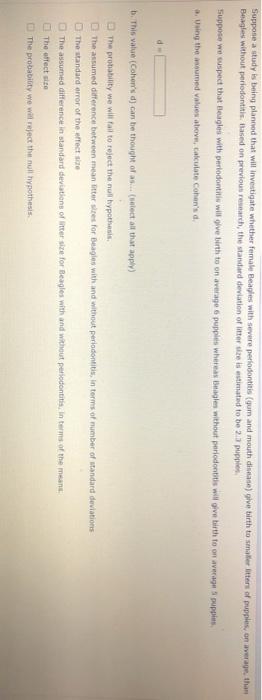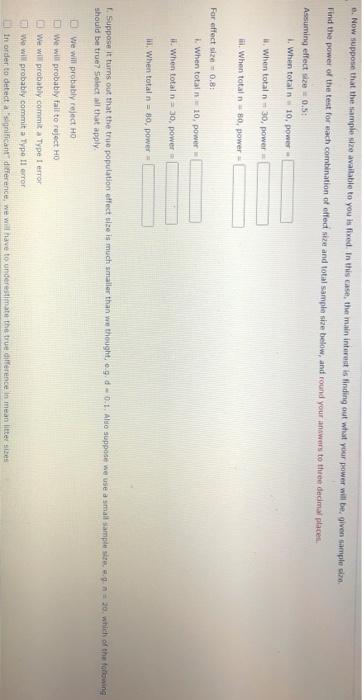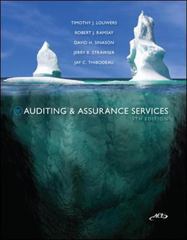Suppone a study is being planned that will investigate whither female Beaglets with severe perfodontitis (gum and mouth diware) ghe birth to smaller Itters of supplies, on average, than Beagles without periodontitie. Based on previous research, the standard deviation of interesestimated to be 21 puppies Suppose we suspect that tengles with periodonthou will give birth to on average o pupols whereas Bagles without periodontitis will give birth to on averagus cuppies, Using the womed values above, calculate Cohen's d b. This value (Cohen's d) can be thought of astet all that apply) The probability we will fail to reject the null hypothesis The assumed difference between mean tersires for Beagles with and without periodontitis, in terms of number of standard deviations The standard error of the effects The assumed difference in standard deviations of bitter size for Beagles with and without periodontitis. In terms of the meant The effect size The probability we will reject the null hypothesis c. Let's assume that population effect size is Cohen's dr. in practice the population effect size is unknown, so we use a value for an efect we'd be interested in discovering for sach value of desired power, find the total sample size be the sample size for both groups combined) required to detect this effect. Use the "Sample Ste and Power tool in JMP, found under the DOE / Design Diagnostics menu. If you have trouble, take a look at the dass example on power 1. For power 0.55, required li. For power -0.75. required For power 0.95, required n = d. Now let's see what happens to these calculations if we assume the effect size is a little bit target. Using d 0.0, re-do the calculations from partc above 1. For poner 0.55, required For power 0.75, required For power = 0.95, required e. Now suppose that the sample size available to you is fixed. In this case, the main interest is finding out what your power will be given sample size Find the power of the test for each combination of effect size and total sample size below, and round your answers to three decimal places Assuming effect size 0.50 1. When totaln10, power When total n = 30, power When total 80, power For effect size-0.8: When total LO, power When total 30, power When total 80, power Suppose it turns out that the true population effect size is much smaller than we thought, og d-0.1. Also suppose we use a small samples. n which of the following should be true? Select all that apply We will probably reject HO We will probably fail to reject HD We will probably commit a Type 1 error We will probably commit Type Il error in order to detect a significant difference, we will have to underestimate the trut difference in mean litteris Suppone a study is being planned that will investigate whither female Beaglets with severe perfodontitis (gum and mouth diware) ghe birth to smaller Itters of supplies, on average, than Beagles without periodontitie. Based on previous research, the standard deviation of interesestimated to be 21 puppies Suppose we suspect that tengles with periodonthou will give birth to on average o pupols whereas Bagles without periodontitis will give birth to on averagus cuppies, Using the womed values above, calculate Cohen's d b. This value (Cohen's d) can be thought of astet all that apply) The probability we will fail to reject the null hypothesis The assumed difference between mean tersires for Beagles with and without periodontitis, in terms of number of standard deviations The standard error of the effects The assumed difference in standard deviations of bitter size for Beagles with and without periodontitis. In terms of the meant The effect size The probability we will reject the null hypothesis c. Let's assume that population effect size is Cohen's dr. in practice the population effect size is unknown, so we use a value for an efect we'd be interested in discovering for sach value of desired power, find the total sample size be the sample size for both groups combined) required to detect this effect. Use the "Sample Ste and Power tool in JMP, found under the DOE / Design Diagnostics menu. If you have trouble, take a look at the dass example on power 1. For power 0.55, required li. For power -0.75. required For power 0.95, required n = d. Now let's see what happens to these calculations if we assume the effect size is a little bit target. Using d 0.0, re-do the calculations from partc above 1. For poner 0.55, required For power 0.75, required For power = 0.95, required e. Now suppose that the sample size available to you is fixed. In this case, the main interest is finding out what your power will be given sample size Find the power of the test for each combination of effect size and total sample size below, and round your answers to three decimal places Assuming effect size 0.50 1. When totaln10, power When total n = 30, power When total 80, power For effect size-0.8: When total LO, power When total 30, power When total 80, power Suppose it turns out that the true population effect size is much smaller than we thought, og d-0.1. Also suppose we use a small samples. n which of the following should be true? Select all that apply We will probably reject HO We will probably fail to reject HD We will probably commit a Type 1 error We will probably commit Type Il error in order to detect a significant difference, we will have to underestimate the trut difference in mean litteris









